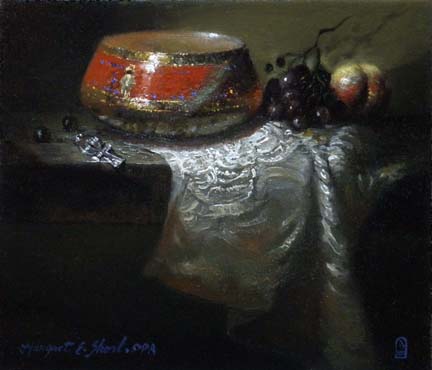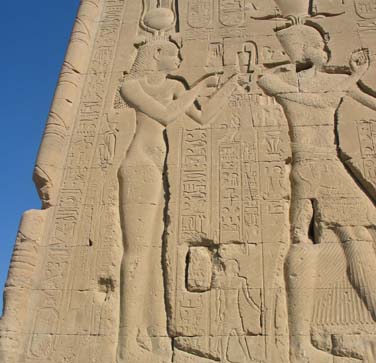Hathor’s Offering
Sold
8×9 Oil on Linen
© Margret E. Short 2009
Lessons from the Pharaoh’s Tomb
Lawrence Gallery, Portland, Oregon September & October 2009
Hathor’s Offering is the smallest in the main collection of twelve paintings and measures 8×9 inches. It was inspired by the beautiful red bowl I purchased in Egypt which has an inscription across the rim telling the story of Hathor, the great cow goddess. She is most certainly my personal favorite and held immense importance in ancient life where there were nineteen temples built in her honor all across Egypt.
Hathor, the daughter of the sun god Ra, was the mother goddess and was responsible for fertility, conception, love, death, beauty and just about everything and so was known as The Goddess of Everything. She was represented as human with a cow head because of the cow’s nurturing and mothering nature. Other titles were Goddess of the Western Mountain and Lady of the Sycamore. In these roles, she gave sycamore figs as sustenance to the deceased and protected cemeteries on the west side of the Nile.
My painting is done with a very limited palette of ochres, red iron oxide heightened with madder, white, Egyptian blue, and black. To the left of the bowl is an ankh, the potent symbol of everlasting life. This sign originates from a hieroglyphic sign of life and is associated with sa, magical protection.
Hathor’s main cult center is Dendera which we visited after arriving in Luxor. I took this picture while touring the vast grounds of the temple. It is clear to see the importance of this goddess by the immense size of the temple which houses various sanatoriums (restoring baths), birthing centers, wells, and chapels. My 8×9 painting is but a mere token to her significance.
Lawrence Gallery, Portland, Oregon




Beautiful still life! The silver cloth looks amazing.
Great work…I like it!!!
I think I like Isis as much as I do Hathor. The painting is gorgeous.